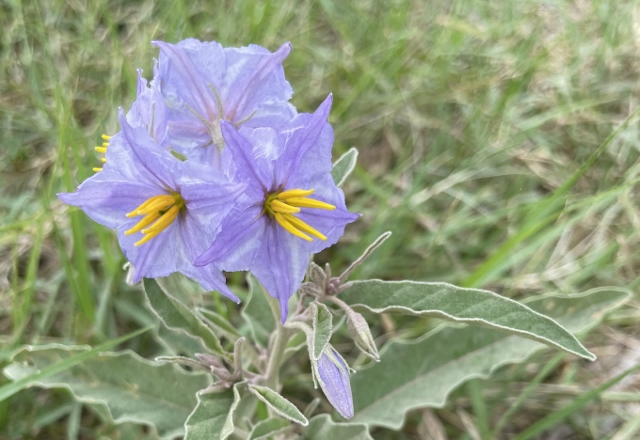
Nightshades are a peculiar family of plants. With nearly 2,300 species worldwide, they range from exceedingly nutritious to dangerously poisonous.
Nightshade plants belong to the Solanacaea family of plants; most are toxic. The primary toxin is solanine.
On the dark side, we get the deadly nightshade, Atropa belladonna, from Eurasia. It has been a popular weapon of choice with the ladies by authors of classic British murder mysteries — the idea perhaps was taken from historical events of ancient Rome. Belladonna has been introduced into America and Canada and other parts of the world. If it grows in Texas, no one is saying . . . .
I did find a gardening column in a San Francisco newspaper where the author of the article wasn’t afraid to be somewhat specific as to where the infamous plant might grow in America. According to an article by Karyn Maier, homeguides.sfgate.com, “Belladonna thrives in a warm, moist, sheltered environment with organically rich soil, making woodland settings in U.S. Department of Agriculture zones 5 through 9 ideal. Although this plant is not original to North America, it was introduced and is now naturalized in a limited region of the Northeast and more widely throughout the Pacific Northwest.” Other sites say that the plant has been introduced to many countries throughout the world. It’s not without merit because it has been used medicinally since the Middle Ages — very, very carefully . . . .
If you’re interested, the Missouri Botanical Garden site, always an interesting read, has an informative page — search Atropa belladonna at missouribotanicalgarden.org.
On the edible side of the nightshade family are two of America’s most popular foods: French fried potatoes and tomato Ketchup.
Along with tomatoes and both white and red potatoes, other edible, nutritious and economically important food crops in the nightshade family include hot and sweet peppers, eggplants and tomatillos. The fruit in these nightshade species is safe because the toxic compound is lowered to nontoxic levels once the fruits and vegetables ripen; the foliage and stems are never safe to eat as they contain concentrated amounts of the toxic alkaloids. Be cautioned, with deadly nightshade, Atropa belladonna, all parts of the plant are poisonous whether the fruits are ripe or not.
Interestingly, for lovers of America’s most famous vegetable — don’t eat green potatoes. According to numerous Internet sites, potatoes should be stored in the dark because light produces chlorophyll (and also solanine) in potatoes — if a potato appears green, best to toss it is the general recommendation.
On the wild side, about 100 species of nightshade can be found in North America. Other than those listed above as edible, 12 solanum species of nightshade occur naturally in Texas — of those, the following nightshades have been reported as found in the Rio Grande Valley, according to information found at an iNaturalist link:
Silverleaf nightshade (Solanum elaeagnifolium) is perhaps the showiest with its sturdy, grayish-green hairy leaves. The flowers are like a five-point starburst about an inch in diameter; their blooms are in clusters of dark purple to pale lavender flowers with yellow nectar guides and yellow stamen. Sometimes the petals are white. The fruit is a small, yellow berry that turns black. White-tailed deer, javelinas and birds eat the fruit; bobwhite quail eat the seeds. The plant reproduces by seed and from the roots.
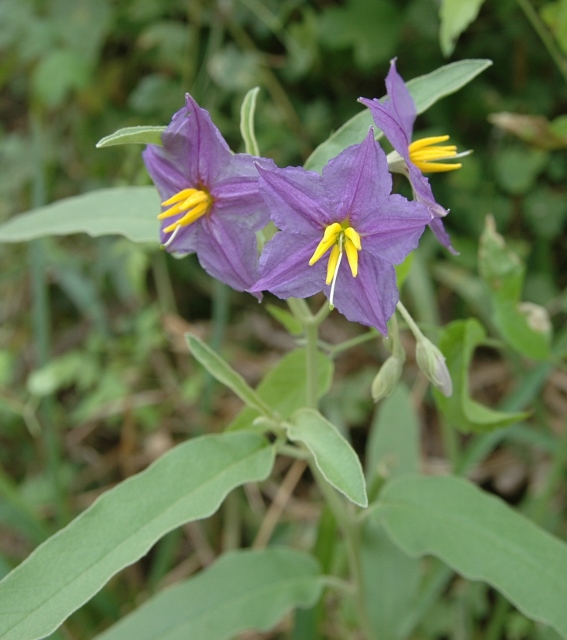
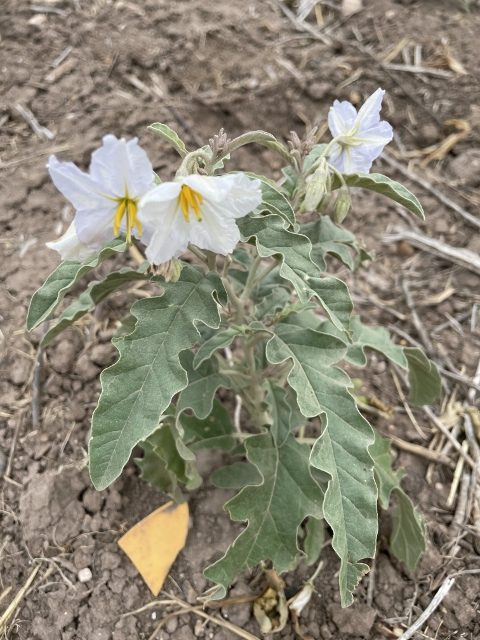
Texas nightshade (Solanum triquetrum) is prevalent in the Valley. It is recognized by its spindly stems that can get quite tall, especially adjacent to a fence or supported by neighboring plants. The blooms are small white flowers with bright yellow stamen. The leaves are small, elongated triangular shaped; the flowers face downward. The ripe berries are bright red about one-half inch in diameter.
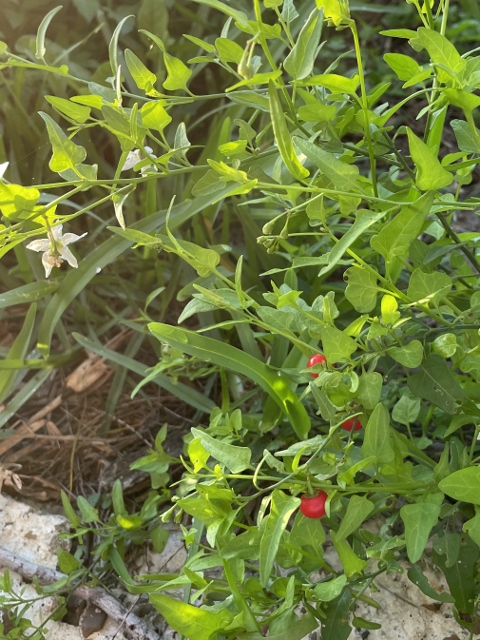
Eastern black nightshade (Solanum ptychanthum) is a plant I found during this year’s City Nature Challenge. It was growing in my yard in the shelter of a quite large Berlandier’s fiddlewood (Citharexylum berlandieri). The Eastern black nightshade is a multi-branched, somewhat spindly and easily snapped, upright plant with a growth height to four feet. The blooms are small white, quarter-inch drooping flowers with yellow anthers. Small green berries turn black when ripe. I was excited to find this third “yard” species of nightshade until I discovered they are sometimes eaten by raccoons and rodents — two critter groups I don’t need to encourage.
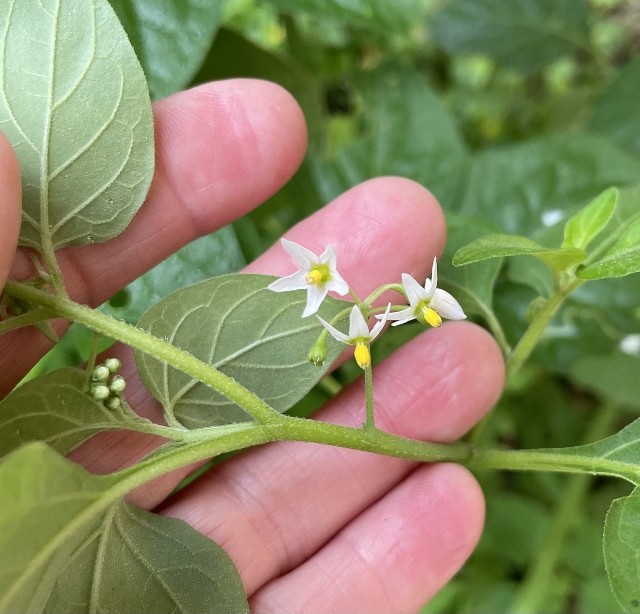
Redberry nightshade (Solanum campechiense) is listed as mostly in the Rio Grande Valley. It is not one I’ve yet found. Texas photographer Robert L. Stone provided this photograph of S. campechiense for the Lady Bird Johnson Wildflower Center at wildflower.org. This nightshade can grow up to two feet in height and is spiny. The flowers are whitish/blue; the fruit is a green striped berry about 5/8 inches in diameter and also is spiny.
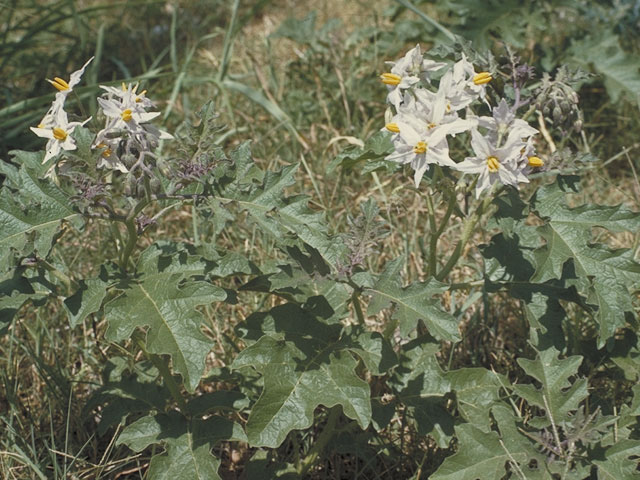
I photographed the leaves of a plant during this year’s City nature Challenge that was identified as Solanum dimidiatum, Western horse nettle, a nightshade family plant documented as being found across most of Texas. My eye was caught by the dramatic cookie-cutter-like-design of the leaves and their sturdy, near-cardboard texture. I almost did not photograph it, thinking it was yet another silverleaf nightshade plant, possibly on steroids. Were it in bloom, it would have looked like the lavender petals and yellow stamen of silverleaf nightshade. The fruit, had I found it, would be large round berries up to one and a half inches in diameter that turn yellow when mature.
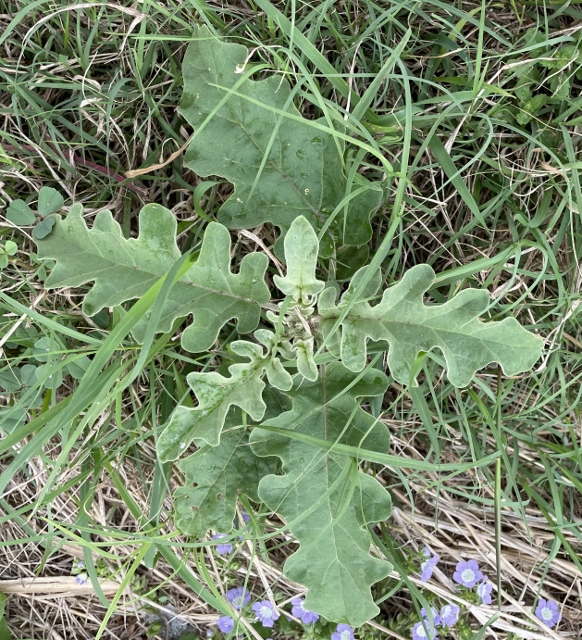
In February 2017, I snapped a photo of what may be American black nightshade (Solanum americanum), a nightshade that the U.S. Department of Agriculture reports occurrences only in the Texas panhandle, but iNaturalist records it as occurring mostly in the eastern third of the state. Whether that designation includes the Deep South of Texas is unclear, however, local authors Alfred Richardson and Ken King describe it as being distributed in Cameron and Hidalgo counties in their book, “Plants of Deep South Texas,” on page 399.
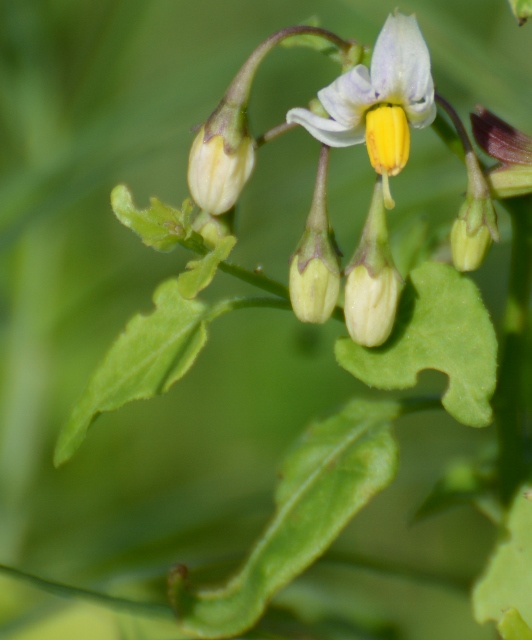
The potato tree, (Solanum erianthum), a butterfly garden favorite, is listed in the iNaturalist site as the 12th solanum found in Texas. The potato tree’s northern most range is the Rio Grande Valley. It is relatively fast-growing and can reach heights of six feet or more with a girth of about 10 feet, possibly larger if it likes where it’s growing. The tree takes well to pruning when it gets unruly; left to its own devices, it usually has a great, flattish-topped umbrella shape. The tree produces hundreds of clusters of white flowers with yellow stamen that bloom spring through fall. Although not particularly showy, the flowers quickly turn into round green fruits, in clumps like grapes, that turn to several shades of yellow before maturing to a deep orange shade. Chachalacas and other critters eat the fruit; even the unripe fruit is a nectar source for butterflies, like tawny and hackberry emperors. Stink bugs lay eggs on the large leaves and the resulting larvae provide food for lizards. Flies, wasps, bees, bugs and a variety of butterflies, moths and birds use the flowers, fruits and leaves in a variety of ways and use the tree for shelter. Wasps and beetles get nectar from the ripened fruit. The tree is a host plant for the creamy stripe-streak butterfly. With all its attributes, it seems to me to be the most beneficial local nightshade in the garden.
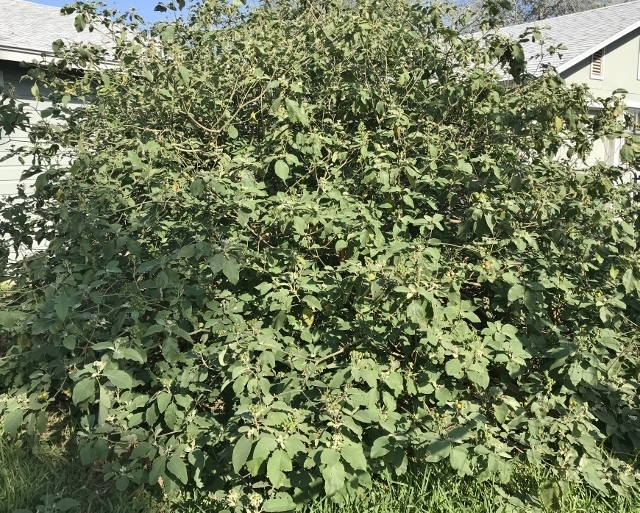
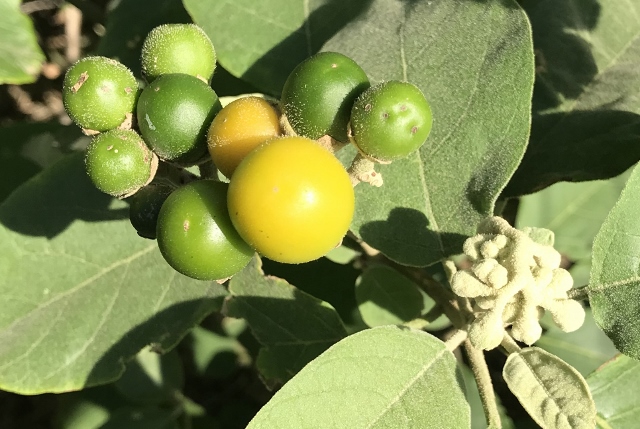
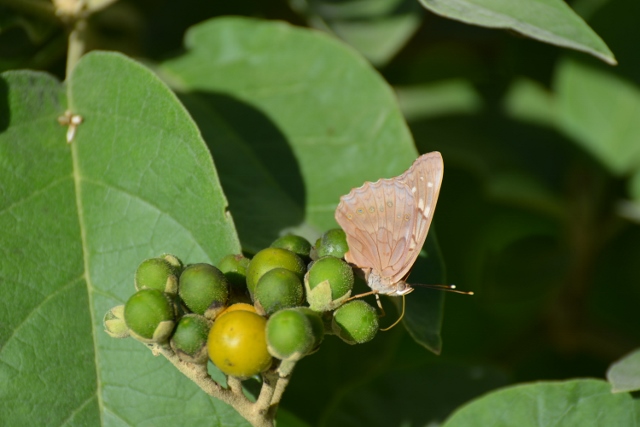
The flowers of these wild nightshades are occasionally visited by bees and butterflies, but they are not a remarkable nectar source. The fruits may be consumed by some birds. Some moths may use nightshades as a host plant. The foliage can sometimes be recognized by its odiferous leaves, like those of cultivated tomato plants; the powerful scent is a clue to the strong chemicals contained in the leaves and stems. Handling some nightshades may cause skin irritations; it is safer to wear gloves when working with nightshades, even domestic tomato plants.
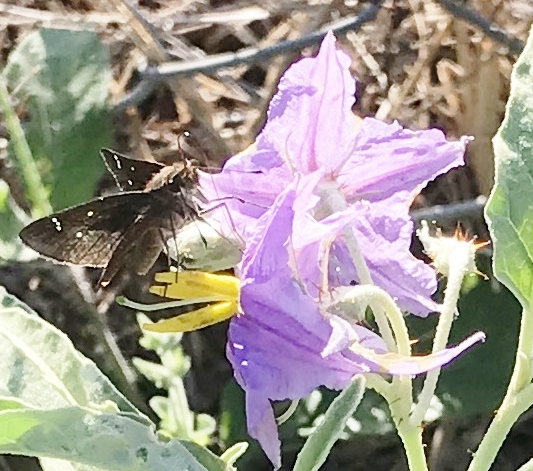
What an excellent and fascinating article! Thank you, Anita!
Thank you — and there’s more on this family of plants — stay tuned!
Those little ones with the bright red berries that look just like tomatoes in miniature are edible? Or no? I would love potato trees if not for that propensity to send out rizomes(?) all over the place and the resultant multitude of new ones where you least want them.